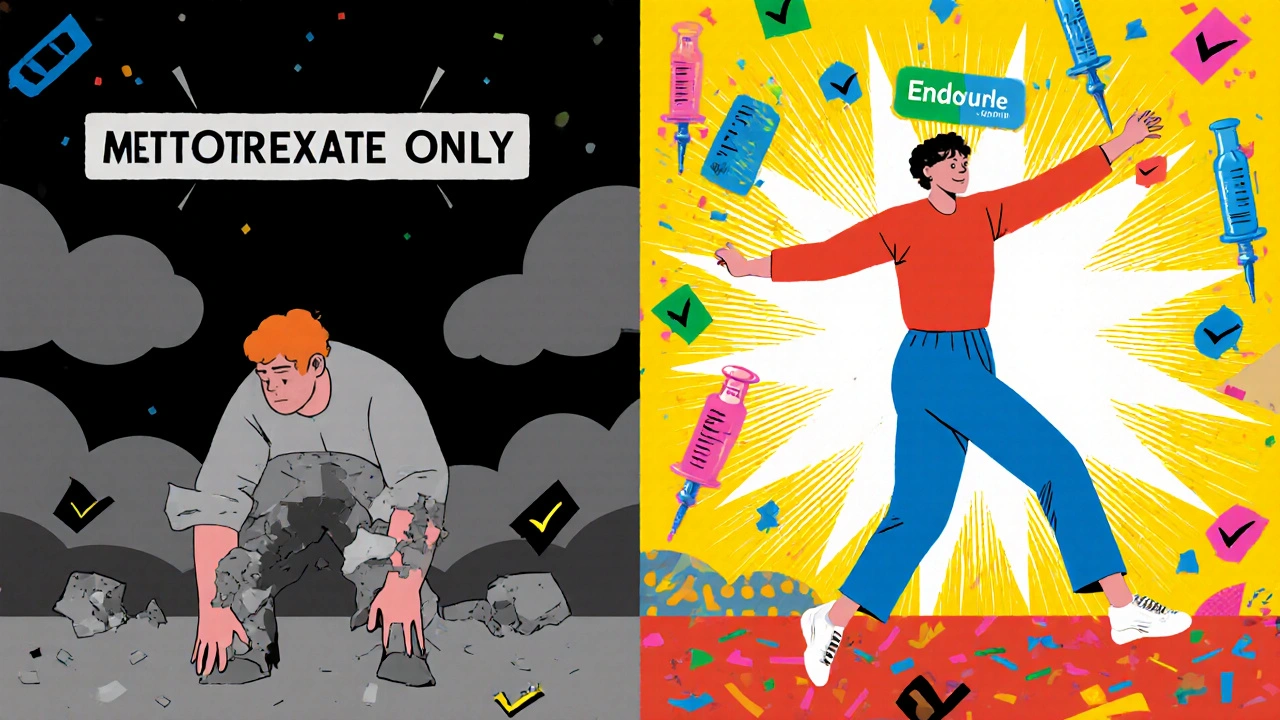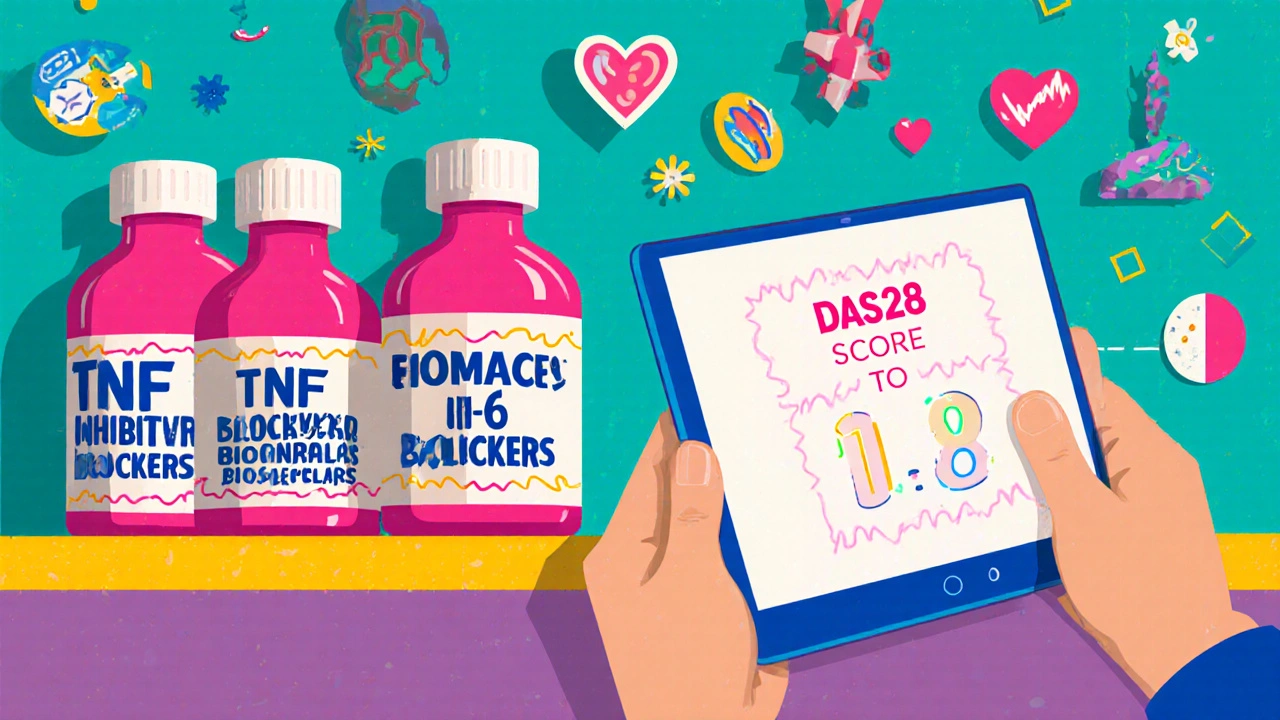For many people with rheumatoid arthritis (RA), the daily pain, stiffness, and swelling aren’t just uncomfortable-they’re life-limiting. Before biologic DMARDs came along, RA was often a slow, relentless march toward joint destruction and disability. Today, that’s no longer the norm. With the right treatment, remission isn’t just a hope-it’s a realistic goal for a significant number of patients.
What Are Biologic DMARDs?
Biologic DMARDs, or disease-modifying antirheumatic drugs, are a class of targeted therapies designed to block specific parts of the immune system that drive inflammation in RA. Unlike older drugs like methotrexate that work broadly across the immune system, biologics act like precision missiles. They zero in on molecules like tumor necrosis factor (TNF), interleukin-6 (IL-6), or T-cells that are overactive in RA. The first biologic approved for RA was etanercept (Enbrel) in 1998. Since then, more than a dozen have hit the market. These drugs don’t cure RA, but they can stop or slow joint damage, reduce pain, and help people return to normal daily life. The goal isn’t just to feel better for a few weeks-it’s to reach remission, where symptoms fade, inflammation drops to near-zero, and X-rays show little to no progression of damage.How Do Biologics Compare to Traditional RA Drugs?
Methotrexate is still the first-line treatment for most RA patients. It’s cheap, well-studied, and works for many. But about half of people don’t get enough relief from it alone. That’s where biologics come in. When methotrexate fails, doctors turn to biologics. Studies show that 20-50% of patients achieve remission with biologics, compared to only 5-15% with methotrexate alone. That’s a huge jump. Biologics also slow joint damage far better than older drugs. One large study found that patients on biologics had 70% less joint erosion over two years than those on methotrexate only. But biologics aren’t magic. They’re expensive-costing $50,000 to $70,000 a year in the U.S. And they come with risks, mainly serious infections like tuberculosis or pneumonia. That’s why doctors test for latent TB before starting treatment and monitor patients closely.Types of Biologic DMARDs: TNF vs. Non-TNF
Not all biologics are the same. They’re grouped by what they target. TNF inhibitors are the oldest and most widely used. These include:- Etanercept (Enbrel)
- Adalimumab (Humira)
- Infliximab (Remicade)
- Golimumab (Simponi)
- Abatacept (Orencia) - blocks T-cell activation
- Rituximab (Rituxan) - depletes B-cells
- Tocilizumab (Actemra) - blocks IL-6 receptors
- Anakinra (Kineret) - blocks IL-1

JAK Inhibitors: The New Kids on the Block
JAK inhibitors like tofacitinib (Xeljanz), baricitinib (Olumiant), and upadacitinib (Rinvoq) aren’t technically biologics-they’re small-molecule drugs taken as pills. But they’re grouped with biologics because they target the same inflammatory pathways inside cells. They’re faster-acting than many biologics and easier to take. In head-to-head trials, upadacitinib beat adalimumab in achieving remission. Baricitinib showed 28% higher remission rates in patients who didn’t respond to other biologics. But they come with warnings. The FDA has placed black box warnings on JAK inhibitors for increased risk of heart problems, blood clots, and certain cancers in older patients or those with risk factors. That means they’re usually reserved for patients who haven’t responded to biologics or can’t tolerate injections.Who Gets Biologics-and When?
Not everyone with RA needs a biologic. Guidelines from the American College of Rheumatology and EULAR are clear: start with methotrexate. Add a biologic only if disease activity stays high after 3-6 months. Doctors use tools like the DAS28 score to measure disease activity. It checks joint swelling, pain levels, and blood markers like CRP. If the score stays above 3.2 after six months on methotrexate, it’s time to consider a biologic. The earlier you start, the better. Studies show patients who begin biologics within the first year of diagnosis have the highest chance of remission. Delaying treatment increases the risk of permanent joint damage.Success Stories and Real-World Challenges
On patient forums, stories of transformation are common. One woman in Melbourne, diagnosed with severe RA at 34, couldn’t open a jar or walk without pain. After starting tocilizumab, her symptoms vanished in eight weeks. She’s been in remission for four years. But it’s not all smooth sailing. About 30-40% of patients don’t respond to their first biologic. Some lose response over time-what’s called secondary failure. A 2021 study found that 40% of patients saw their drug lose effectiveness after 12-24 months. Side effects are real. Injection site reactions happen in nearly half of users. Infections are the biggest concern. One man in Sydney developed pneumonia after starting adalimumab and had to stop treatment. Others struggle with the cost. Even with insurance, co-pays can hit $500 a month. Biosimilars-cheaper copies of biologics-are helping. They’re 15-30% less expensive and work just as well. In the U.S., they now make up 35% of TNF inhibitor prescriptions. More patients are switching to them, especially as insurers push for cost savings.
Getting Started: What You Need to Know
If your doctor suggests a biologic, here’s what to expect:- Testing first: Blood tests for TB, hepatitis, and immune function are required.
- Training: Most biologics are self-injected. Nurses teach you how to store, prepare, and inject the drug. Most patients master it after two sessions.
- Waiting period: Insurance approval can take 7-14 days. Some manufacturers offer patient assistance programs that cover up to 100% of costs.
- Monitoring: You’ll need blood tests every 3-6 months to check for infection or liver issues.
What’s Next for RA Treatment?
The future of RA treatment is personalization. Researchers are studying synovial tissue biopsies to see which immune pathways are active in each patient. That could mean matching a patient to the right drug from day one, instead of trying one after another. Longer-acting biologics are in development. A twice-yearly injection of tocilizumab is in late-stage trials. If approved, it could cut the number of shots from 52 a year to just two. Biosimilars will keep growing. By 2027, they’re expected to make up 60% of the biologic market. That could make treatment affordable for millions more people, especially in countries where cost has been a barrier. The dream isn’t just remission anymore-it’s cure. Scientists are exploring ways to reset the immune system entirely. Early trials are promising, but we’re not there yet.Final Thoughts
Biologic DMARDs changed everything for rheumatoid arthritis. What was once a life sentence of pain and disability is now a manageable condition for many. Remission isn’t rare-it’s achievable. But it requires patience, persistence, and the right match between patient and drug. If you’re on methotrexate and still hurting, talk to your rheumatologist. Don’t wait. The window to prevent joint damage is narrow. And if cost is a concern, ask about biosimilars or patient assistance programs. You don’t have to accept pain as your new normal.Can biologic DMARDs really lead to remission in rheumatoid arthritis?
Yes. Studies show that 20-50% of RA patients achieve remission with biologic DMARDs, compared to only 5-15% with traditional drugs like methotrexate alone. Remission means minimal or no symptoms, low inflammation, and little to no joint damage progression. It’s not a cure, but it allows many people to live normally without daily pain or disability.
How long does it take for biologics to start working?
TNF inhibitors like adalimumab or etanercept often start working in 2-4 weeks, with full effects seen by 12 weeks. Non-TNF biologics like abatacept or tocilizumab may take longer-up to 3-6 months-to reach their full effect. JAK inhibitors, taken as pills, tend to work faster, sometimes within days. Patience is key, but if there’s no improvement after 3 months, your doctor may switch you to another drug.
What are the biggest risks of using biologic DMARDs?
The main risk is serious infections, including tuberculosis, pneumonia, and fungal infections. Biologics suppress parts of the immune system, making it harder to fight off germs. Before starting, you’ll be tested for latent TB and hepatitis. Other risks include injection site reactions (common), increased risk of certain cancers (rare), and, for JAK inhibitors, higher chances of blood clots and heart problems in older patients or those with risk factors.
Why do some people stop responding to biologics over time?
This is called secondary non-response. It happens in about 40% of patients after 12-24 months of treatment. The immune system can develop antibodies against the drug, making it less effective. It can also happen if the underlying inflammation shifts to a different pathway. When this occurs, switching to a biologic with a different mechanism-like going from a TNF inhibitor to an IL-6 blocker-often helps.
Are biosimilars as effective as the original biologics?
Yes. Biosimilars are highly similar to the original biologic in structure, function, and clinical effect. Studies show they work just as well and have the same safety profile. In the U.S., biosimilars now make up 35% of TNF inhibitor prescriptions. Many patients switch successfully and save 15-30% on costs. Insurance companies often push for biosimilars first because they’re cheaper.
Can I stop taking biologics if I go into remission?
Some patients do, but it’s risky. Stopping biologics increases the chance of flare-ups-up to 60-80% of patients relapse within a year. Doctors rarely recommend stopping unless you’ve been in deep remission for over a year and have very low disease activity. Even then, it’s done cautiously, with close monitoring. Most patients stay on therapy long-term to keep the disease under control.


1 Comments
Justin Daniel
November 23, 2025 AT 14:51So let me get this straight-after decades of treating RA like it’s a bad roommate you can’t kick out, we now have drugs that actually *listen* to your immune system? Wild. I’m not crying, you’re crying.